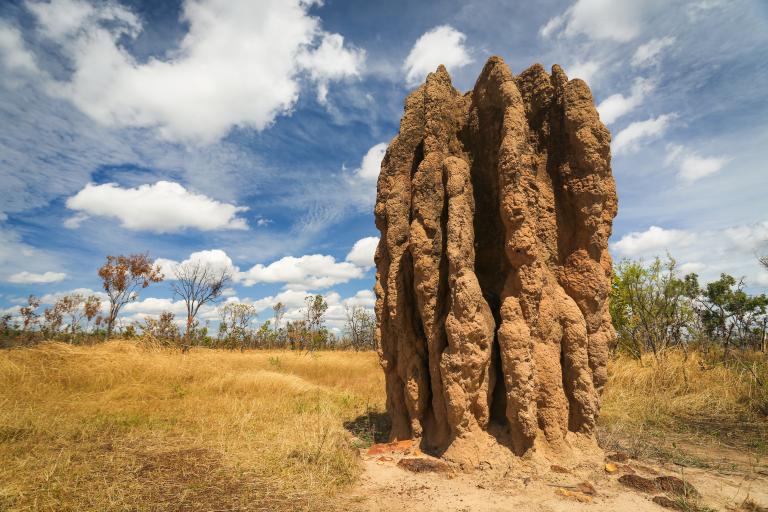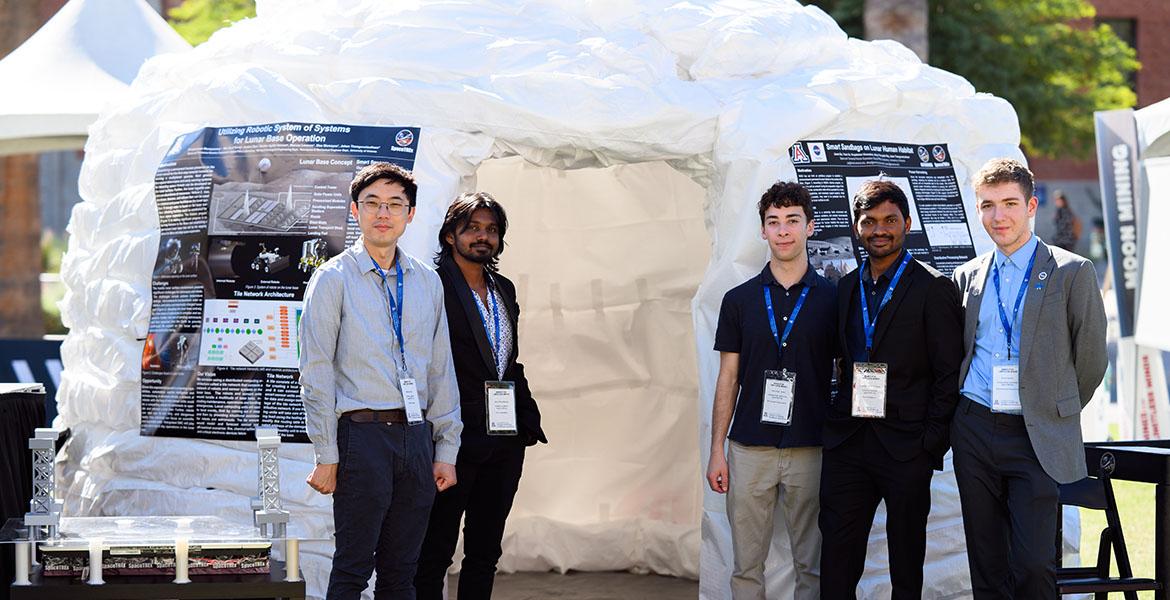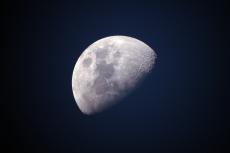Cathedral Termite Mounds Inspire UA Engineering Lunar Structures
NASA has big plans for its Artemis program – to return Americans to the moon for the first time since 1972 and establish a lunar base for humans by the end of the decade.
With NASA funding, a team of University of Arizona engineers is using robot networks to create termite-inspired structures that will help astronauts survive the moon's harsh environment.
Associate professor Jekan Thanga and his students in the Department of Aerospace and Mechanical Engineering have developed prototypes of their lunar sandbag structures and the underlying concept for a network of robots that can build them. The structures contain sensors that aid in construction, then alert astronauts to changes in environmental conditions. Tech Launch Arizona, the university’s commercialization arm, worked with Thanga to file patents on the distributed computer processing networks that the team developed to link together these structures and robots.
Sivaperuman Muniyasamy, an aerospace engineering doctoral student, and Thanga presented a paper detailing the technology on Feb. 1 at the American Astronautical Society Guidance, Navigation and Control Conference.
"By publishing the paper at the conference, we're gaining feedback from other experts that really helps us move forward," said first author Muniyasamy.
Teaming Up for Moon Landings
Thanga estimates astronauts will first land on the moon as part of Artemis in 2026 or 2027. In a consortium called LUNAR-BRIC, his team is partnering with NASA's Jet Propulsion Laboratory at Caltech and MDA, a space robotics company, to develop technology for Artemis moon landings.
"It's no accident this team has an academic partner, a commercial partner and a government agency," Thanga said. "Given the challenges, part of the path is for us to collaborate."

The moon structures are just a start for Thanga's university team and LUNAR-BRIC in their quest to support a space economy. Within a few years of the first successful landing, he said, NASA will look to building facilities for long-term habitation and industry, such as environmentally responsible moon and asteroid mining.
Moon dwellers will need semi-permanent safe shelters while they search for optimal locations to erect permanent buildings, Thanga said, adding that he is confident the fundamentally simple sandbag structures will be employed.
Insect Society and Architectural Inspiration
Thanga was first intrigued by a YouTube video showing the work of Nader Khalili. In the 1980s, the late architect presented to NASA the idea of sandbag structures for lunar and space habitation. Then Khalili developed SuperAdobe sandbag construction for homes around the world.
Thanga layered onto Khalili's ideas the concepts of insect skyscrapers. These cathedral termite mounds common in African and Australian deserts regulate the subterranean nest environment.
"In the case of the termites, it's very relevant to our off-world challenges. The extreme desert environments the termites face are analogous to lunar conditions," Thanga said. "Importantly, this whole approach doesn't rely on water. Most of the moon is bone-dry desert."

Thanga has long been interested in applying the architecture of insect social systems – like a termite colony constructing and maintaining a large, complicated mound – to distributed robot networks, in which machines work together cooperatively without human intervention.
"Learning about that helped direct me toward distributed systems for construction," he said.
Thanga's team investigated whether sandbags filled with regolith, soil and mineral fragments from the moon's surface, could replace traditional building materials for lunar housing, warehouses, control towers, robot garages, landing pads, protective jackets for robots, and blast walls to protect assets during turbulent takeoffs and landings.
The quickly and easily robot-assembled sandbag shelters reduce the material that must be transported to the moon, provide good climate control, and protect against moonquakes and other hazards.
Robots embed sensors and electronics in the sandbags and fill them with lunar regolith before assembling the structures in place. Some sensors provide location data to help the robots place the sandbags. Others supply environmental information and communication capabilities to warn of danger. On the moon, temperatures range from -298 to 224 degrees Fahrenheit; micro-meteors bombard the surface at an average of 60,000 mph; and solar radiation and lunar dust threaten exploration.
Serving Underrepresented Students
NASA has granted Thanga's team $500,000 for lunar surface projects through the agency's Space Technology Artemis Research program, or M-STAR, which is part of NASA's Minority University Research and Education Project, or MUREP. Those funds extend until summer 2024. Funding from another MUREP program, MIRO, helps cover costs of the lunar projects.
MIRO, which supports STEM research and education at Minority-Serving Institutions, has provided $1 million a year for UA student research projects over the last five years.
"The goal is to raise the participation of underrepresented groups in aerospace," Thanga said. "And these are hands-on, student-centric projects."
Muniyasamy, who moved from India to study at the university and plans to launch a space mining company after completing his PhD, leads a team of eight undergraduate and master's students working on lunar surface projects.
"This lab offers me the exact environment – it's startup culture," he said. "I'm leading a team and working with multidisciplinary people. I'm glad I'm here."




